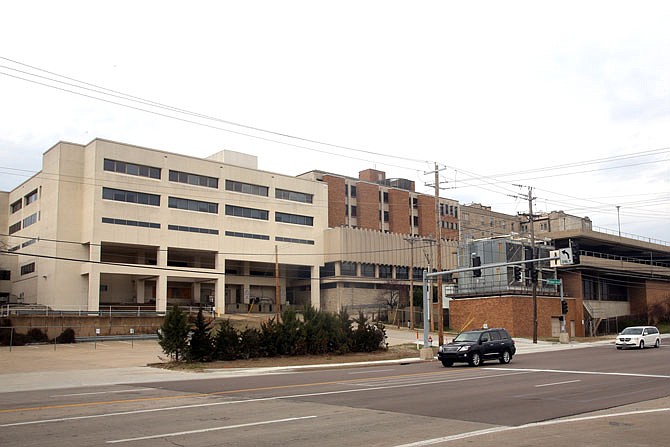After more than 100 years in use and over two years shuttered, public funding support could revive the former St. Mary's Health Center property in Jefferson City.
F&F Development, whose subsidiary is Farmer Holding Company, purchased the property in December 2015 after SSM Health relocated the hospital to its current location on Mission Drive in November 2014.
The developer is seeking tax increment financing through the Jefferson City government to aid in redeveloping the site for commercial - and perhaps even educational - purposes.
The company now proposes to redevelop 9.8 acres at the southwest corner of U.S. 50 and Bolivar Street, near downtown Jefferson City, offering two potential redevelopment project options in its TIF plan filed with the city.
Both options would include historic preservation of the original, 1905 St. Mary's Hospital, converting the structure into office space.
The first plan, dubbed the "Lincoln Project," would create a satellite location for Lincoln University - a throwback to plans discussed in 2014 before F&F Development bought the St. Mary's property and before then-Gov. Jay Nixon vetoed state budget appropriation that would have funded renovating part of the hospital for use by LU's nursing program, alongside several State Technical College of Missouri programs.
The Lincoln Project would create an approximately 180,000-square-foot educational center for the university. "The goal would be to build a new location closer to the governmental center of the state and the business center of the city to provide greater educational opportunities for Lincoln's students," according to the TIF plan.
LU officials were not prepared to comment on the proposal Tuesday, Misty Young, director of university relations, told the News Tribune.
Alongside Lincoln's satellite campus, the developer would build out a "commercial pad site development, focused on high-end restaurants and retail," with four spaces available for retail/restaurant buildings.
The Lincoln Project, estimated to cost more than $44 million, is F&F Development's preferred redevelopment option, according to the TIF plan.
The LU satellite campus depends especially on a planned $10 million in state financing, the potential of which F&F Development anticipates to be determined during the 2017 legislative session.
The second redevelopment option, sans LU - the "Commercial Project" - favors commercial use more heavily, offering six retail/restaurant building slots. This option is estimated to cost roughly $30.6 million.
Upon approval, demolition and site work would begin this year, with anticipated completion in late 2018, according to the TIF plan.
Tax increment financing (TIF) allows developers to finance certain improvements in blighted areas using a portion of the additional sales and/or property tax revenue produced in the district that results from the development, until all eligible costs have been reimbursed or for a maximum of 23 years.
With all incentives combined, F&F Development expects a total benefit of $7.43 million for the Lincoln Project or $6.74 million for the Commercial Project in net present value.
The bulk of that would come from the TIF's increased property tax revenue as the assessed value increases with redevelopment. The company anticipates redevelopment will increase the area's assessed valuation from its current $419,300 to $7,580,844 for the Lincoln Project or $4,537,342 for the Commercial Project upon completion.
Additionally, the TIF would allow F&F Development to collect 50 percent of new sales tax revenue in the district to help fund reimbursable costs on an as-collected basis.
The plan also proposes, for the Lincoln Project, 0.75 percent of the district's remaining economic activity taxes not captured by the TIF also support the project via an annual appropriation from the city.
Without the proposed incentives, the plan claims, the Lincoln Project's return to the developer is "incalculable - meaning so below-market that a rate of return cannot be analyzed."
Because the Commercial Project would focus more heavily on sales tax-producing businesses, the developer proposes a smaller annual appropriation for it - at 50 percent of the sales tax revenue not captured by the TIF.
Those "supplemental TIF" appropriations would amass a projected $700,651 for the Lincoln Project or $651,735 for the Commercial Project, according to the TIF plan.
An accompanying Community Improvement District (CID) would impose an additional 1 percent sales tax within the district to finance redevelopment costs. CID revenue is estimated to generate approximately $467,100 for the Lincoln Project or $671,735 for the Commercial Project.
The Jefferson City TIF Commission has scheduled a public hearing for the proposed St. Mary's Hospital TIF Plan at 6 p.m. April 6 at City Hall, where representatives of local taxing districts, as well as other interested parties, may make comments or objections regarding the proposal, according to a Feb. 15 letter from Jefferson City Counselor Ryan Moehlman to the Cole County Commission.
Farmer Holding Company is four years into a TIF at Capital Mall, which the company purchased in 2012 and began renovating in 2015.
Jefferson City's other currently active TIF district is on High Street (O'Donoghue's). The most recent attempt to secure TIF assistance in the city failed - the Puri Group of Enterprises (PGE) had sought roughly $8.89 million from a proposed TIF to redevelop the former Truman Hotel property on Jefferson Street. PGE since has secured public funding assistance for the project through urban renewal, which will provide for 10 years of tax abatement as the developer replaces the now-shuttered hotel with two new ones.

